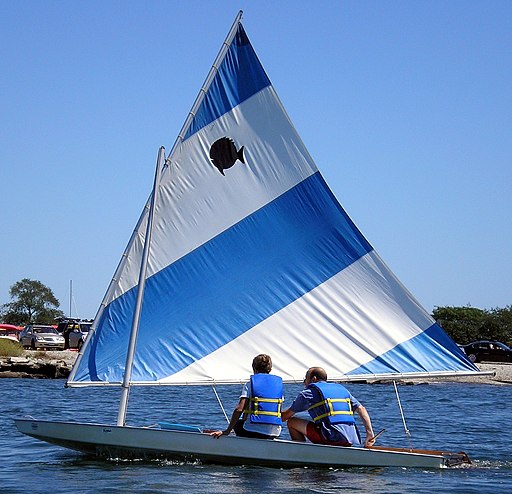“As an Amazon Associate I earn from qualifying purchases at no additional cost to you”
How to Rig a Sunfish Sailboat
The Sunfish is arguably the most popular sailboat on the planet. Its popularity is characterized by its inexpensive price, easy portability (probably the only car-toppable sailboat), and easy to rig and sail with just one control line.
But our focus today is on one critical part – how to rig a sunfish. If you just bought your first Sunfish sailboat, sit back and read through this complete step-by-step guide of rigging this kind of dinghy. I hope you already know the parts of a dinghy but if not, well, that’s a topic for another day.
And off we go:
1: Point the sailboat’s bow into the wind. Why? To keep the sail over the Sunfish when it is raised. This will avoid hitting other people or boats with the booms and make it easier to affix the mainsheet.
2: Lay the spars and sail on the sailboat with the mast ring toward the bow.
3: Untie the sail/spar bundle knot and pull the line to undo the bundle. The spars and sail are usually bundled using the mainsheet and halyard.
4: Attach the Boom Sling. Find a spot around fifteen inches below where your halyard meets the upper boom. Pull one side of the Boom Sling around the upper boom and the halyard. Pull the line through the loop to capture the halyard and upper boom. Now, pull the other end of the line to where the lower boom and upper boom meet, and slide the loop over the end of the boom and into the notch formed by the bolt joining the booms.
5: Properly align the mast and boom. Make sure the boom is on the port side of the mast.
6: Ensure the halyard is running directly from the upper boom to the top of the mast and through the hole at the top of the mast.
7: Be sure that the sail is lying towards the port side of the sailboat, and that the mainsheet isn’t wrapped around anything, but just lying below the lower boom.
8: Align the mast, lower and upper booms so that the mast ring is directly over the mast step.
9: Raise the mast and gently place it in the mast step in the deck. Don’t forget to keep hold of the halyard and make sure it’s running neatly through the masthead fairlead from the back to the front.
10: Guide the end of the halyard via the fairlead to starboard of the mast.
11: Pull the halyard to raise the spar and the sail. Reach down and lift the gooseneck ring so the sail can go all the way to the top of the mast.
12: Tie a cleat hitch in the halyard around 2ft above the cleat and then feed the halyard tail through the cleat hitch and bring it down to fit over the cleat. This helps secure the sail.
13: Ensure the mainsheet runs through all the available sleeves on the boom to stop it from hanging down and catching your neck during tacks and gybes. Tie a cleat knot preferably a figure 8 around the cleat and secure the final turn with an extra twist.
14: Lead the excess halyard tail through the deck fairlead, over the gooseneck and back via the fairlead. Pushing the lower spar down a bit while holding onto the halyard tightly will restrict the spar from rising in harsh winds.
15: Tie another cleat knot on the deck. This one is crucial just in case you capsize as it will keep the sail from falling off the sailboat and sinking. You can tie the extra halyard to the junction of the upper and lower spars with a bowline.
16: Now, run the mainsheet through the ratchet block at the front of the cockpit. Keep in mind that the block only runs in one direction, so be sure to check that first. Tie a stopper knot or figure 8 at the end of the sheet so that it doesn’t get away while you sailing.
17: Tie the other end of the mainsheet to the bridle with a bowline.
18: Fasten the bungee cord affixed to the daggerboard around the mast and then clip it to itself. This is to ensure that the daggerboard stays in the sailboat, as well as supply tension to hold the daggerboard in a partially raised position.
19: Attach the rudder and put the centerboard in its place.
20: Jump in, launch, and go sailing!
And that’s it as far as rigging a Sunfish sailboat is concerned. A piece of advice here is that you need to know at least three types of knots to successfully rig a sailboat: a cleat hitch, a stopper knot or figure 8, and a bowline.
Before you go, let me answer a few frequently asked questions about Sunfish sailboats.
How much is a sunfish sailboat?
A new Sunfish sailboat will set you back at least $4,500 while a used one in good condition will usually fall in the range of $900 to $1,200.
In the case of used boats, there are few things to be keen on. Firstly, a decent used boat should have a smooth hull, uniformly firm with no soft areas, and without deep imperfections or holes.
from PxHere
Secondly, the sailboat ought to be dry sailed, meaning it must have been stored on land, off the ground, and under proper shelter throughout the time when it was not being used. The reasoning behind this is that boats left in water or carelessly stored gain weight quickly, and weight is something you want to keep at a minimum when sailing. I won’t recommend a used Sunfish for competitive sailing unless it’s within a few kilograms of the weight of a new one.
How fast can a sunfish sailboat go?
Now, let’s first be clear that ‘fast’ is always relative because different factors come into play to determine how fast you can go. For instance, a general rule of thumb has it that a lighter boat sails faster than a heavy one. Also, a longer sailboat will record a higher maximum speed than a shorter boat.
What’s more? Boats tend to sail slower in cold waters than in warm waters, and shallow waters decrease boat speed too as the vessel sinks more and has to displace more water out of its way.
Another thing to remember is that Sunfish sailboats are casual-style boats, and so you might want another option if you’re after the need for speed. All in all, a sunfish sailboat can clock 11 knots in favorable conditions. Keep in mind that the official Laser sailboat speed record is 16.8 knots, and Lasers tend to be faster than Sunfish.
How heavy is a sunfish sailboat?
A new Sunfish is typically 120 pounds (54kg).
How to transport a Sunfish sailboat?
Nearly all Sunfish sailboats are cartoppable, thanks to their small and lightweight designs. Simply install the right equipment on the top of your car, such as roof rack and straps, and you’ll find it a doddle transporting your Sunfish. Alternatively, you can buy a trailer and it will save you the work of loading and taking down your sailboat.
How to clean a sunfish sailboat?
Now there’s no formula on how to clean a Sunfish sailboat or any sailboat for that matter. But let me give a few tips on how I do it. I realized that beginning from the topmast to the sails and down to the keel is pretty efficient. Be sure to use non-harmful detergents too.
To clean the sail, first set it down on a clean, flat area. Add some liquid detergent into a bucket of warm water and brush the sail gently to remove debris. You can also clean the sail with your hands, though this process is time-consuming.
As for the hull, I tend to use a pressure washer with a gentle nozzle to remove the worst of the dirt. I then mix a bucket of water and laundry detergent and wash the entire hull using a scrubber or kitchen sponge. Next up is rinsing the whole thing using a clean sponge and plenty of clean water after which I let it dry. Note that your hull (especially fiberglass) might require extra maintenance depending on how dirty and greased it is. Perhaps an extra polish or wax to keep looking nice.
The mast and boom can always do with some scrubbing with soapy water and giving them a good rinse. Bleach can be used to remove tough stains such as mildew.
To cut a long story short, most cleaning involves the use of soapy water, a mild detergent, and a sponge. Just make sure to follow instructions as per the cleaner of your choice.
Conclusion
The Sunfish sailboat is loved by all and the small matter of how to rig a Sunfish is now done and dusted. When the wind is good, just take to the water and have fun zipping about. If you have any additional questions or feedback, feel free to leave a comment below.
PS: Interested in the best drysuits for dinghy sailing? Check out our guide here!
Happy sailing!








